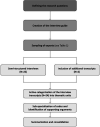The medical profession transformed by artificial intelligence: Qualitative study
- PMID: 36532112
- PMCID: PMC9756357
- DOI: 10.1177/20552076221143903
The medical profession transformed by artificial intelligence: Qualitative study
Abstract
Background: Healthcaare delivery will change through the increasing use of artificial intelligence (AI). Physicians are likely to be among the professions most affected, though to what extent is not yet clear.
Objective: We analyzed physicians' and AI experts' stances towards AI-induced changes. This concerned (1) physicians' tasks, (2) job replacement risk, and (3) implications for the ways of working, including human-AI interaction, changes in job profiles, and hierarchical and cross-professional collaboration patterns.
Methods: We adopted an exploratory, qualitative research approach, using semi-structured interviews with 24 experts in the fields of AI and medicine, medical informatics, digital medicine, and medical education and training. Thematic analysis of the interview transcripts was performed.
Results: Specialized tasks currently performed by physicians in all areas of medicine would likely be taken over by AI, including bureaucratic tasks, clinical decision support, and research. However, the concern that physicians will be replaced by an AI system is unfounded, according to experts; AI systems today would be designed only for a specific use case and could not replace the human factor in the patient-physician relationship. Nevertheless, the job profile and professional role of physicians would be transformed as a result of new forms of human-AI collaboration and shifts to higher-value activities. AI could spur novel, more interprofessional teams in medical practice and research and, eventually, democratization and de-hierarchization.
Conclusions: The study highlights changes in job profiles of physicians and outlines demands for new categories of medical professionals considering AI-induced changes of work. Physicians should redefine their self-image and assume more responsibility in the age of AI-supported medicine. There is a need for the development of scenarios and concepts for future job profiles in the health professions as well as their education and training.
Keywords: Artificial intelligence; digital health; eHealth; health professions; internet; personalized medicine; qualitative studies; technology.
© The Author(s) 2022.
Figures


Similar articles
-
AI Interventions to Alleviate Healthcare Shortages and Enhance Work Conditions in Critical Care: Qualitative Analysis.J Med Internet Res. 2025 Jan 13;27:e50852. doi: 10.2196/50852. J Med Internet Res. 2025. PMID: 39805110 Free PMC article.
-
Future Medical Artificial Intelligence Application Requirements and Expectations of Physicians in German University Hospitals: Web-Based Survey.J Med Internet Res. 2021 Mar 5;23(3):e26646. doi: 10.2196/26646. J Med Internet Res. 2021. PMID: 33666563 Free PMC article.
-
Physicians' Perspectives on AI in Clinical Decision Support Systems: Interview Study of the CURATE.AI Personalized Dose Optimization Platform.JMIR Hum Factors. 2023 Oct 30;10:e48476. doi: 10.2196/48476. JMIR Hum Factors. 2023. PMID: 37902825 Free PMC article.
-
Human Factors and Technological Characteristics Influencing the Interaction of Medical Professionals With Artificial Intelligence-Enabled Clinical Decision Support Systems: Literature Review.JMIR Hum Factors. 2022 Mar 24;9(1):e28639. doi: 10.2196/28639. JMIR Hum Factors. 2022. PMID: 35323118 Free PMC article. Review.
-
Your Robot Therapist Will See You Now: Ethical Implications of Embodied Artificial Intelligence in Psychiatry, Psychology, and Psychotherapy.J Med Internet Res. 2019 May 9;21(5):e13216. doi: 10.2196/13216. J Med Internet Res. 2019. PMID: 31094356 Free PMC article. Review.
Cited by
-
Forecasting the future of smart hospitals: findings from a real-time delphi study.BMC Health Serv Res. 2024 Nov 18;24(1):1421. doi: 10.1186/s12913-024-11895-z. BMC Health Serv Res. 2024. PMID: 39558347 Free PMC article.
-
Biomedical Ethical Aspects Towards the Implementation of Artificial Intelligence in Medical Education.Med Sci Educ. 2023 Jun 7;33(4):1007-1012. doi: 10.1007/s40670-023-01815-x. eCollection 2023 Aug. Med Sci Educ. 2023. PMID: 37546190 Free PMC article.
-
Physicians' required competencies in AI-assisted clinical settings: a systematic review.Br Med Bull. 2025 Jan 16;153(1):ldae025. doi: 10.1093/bmb/ldae025. Br Med Bull. 2025. PMID: 39821209 Free PMC article.
-
Exploring the perspectives of healthcare professionals regarding artificial intelligence; acceptance and challenges.BMC Health Serv Res. 2024 Oct 8;24(1):1200. doi: 10.1186/s12913-024-11667-9. BMC Health Serv Res. 2024. PMID: 39379939 Free PMC article.
-
Artificial intelligence in medicine: A comprehensive survey of medical doctor's perspectives in Portugal.PLoS One. 2023 Sep 7;18(9):e0290613. doi: 10.1371/journal.pone.0290613. eCollection 2023. PLoS One. 2023. PMID: 37676884 Free PMC article.
References
-
- Stanford Medicine 2020 Health Trends Report [Internet]. Stanford Medicine. [cited 2021 Sep 25]. Available from: https://med.stanford.edu/dean/healthtrends.html
-
- High-Level Expert Group on Artificial Intelligence, editor. A definition of Artificial Intelligence: main capabilities and scientific disciplines. Shaping Europe’s digital future [Internet]. 2019 [cited 2021 Jun 21]. Available from: https://digital-strategy.ec.europa.eu/en/library/definition-artificial-i...
LinkOut - more resources
Full Text Sources

